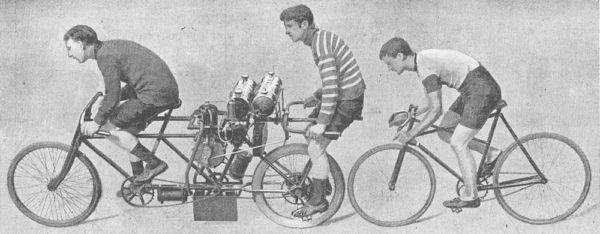
The Anerley Bicycle Club held an important meeting on Saturday September 14, 1901. One of the most interesting events was a record-breaking attempt by Mr A A (Arthur) Chase – which proved successful.
Chase was paced by a motor tandem, and lowered the one mile paced professional record, with a flying start, by one fifth of a second, with a time of 1 minute 27 3/5 seconds – which equates to a speed of 41.1 mph.
Cyclists started to use tandem bicycles as pacers in the late 19th century, and as early as 1898 were known to add engines to the pacing machines to achieve higher speeds.
Arthur Adalbert Chase (born 1874) was a British professional cyclist. He rode for the North Road Club, and first achieved fame in 1893, when he won 13 first prizes in 14 races. At end of 1894 he held all the safety records from 51 to 134 miles. He toured America, Australia and the continent.
After retiring from the professional cycling scene in 1902, he teamed up with his brother F. W. Chase to build motorcycles. Many years after this enterprise, he lodged a patent for an exhaust silencer.
Arthur had been using pacing tandems in the past, and even rode behind an electric pacing tandem when he went up against the famous French cyclist Bouhours in Paris in 1898. He commissioned a UK firm to build a special pacing machine at the start of 1899. The machine was a tandem, with a rear-mounted 1.75 hp de Dion engine. Both riders pedalled, the front one being responsible for steering, the rear for control of the engine. It is possible that this description, from an unknown source, applies to the tandem in our picture.







Leave a Comment